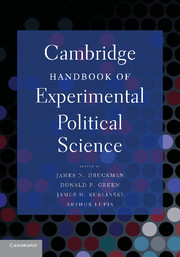Book contents
- Frontmatter
- Contents
- List of Tables
- List of Figures
- Contributors
- Acknowledgments
- INTRODUCTION
- PART I DESIGNING EXPERIMENTS
- PART II THE DEVELOPMENT OF EXPERIMENTS IN POLITICAL SCIENCE
- PART III DECISION MAKING
- 10 Attitude Change Experiments in Political Science
- 11 Conscious and Unconscious Information Processing with Implications for Experimental Political Science
- 12 Political Knowledge
- PART IV VOTE CHOICE, CANDIDATE EVALUATIONS, AND TURNOUT
- PART V INTERPERSONAL RELATIONS
- PART VI IDENTITY, ETHNICITY, AND POLITICS
- PART VII INSTITUTIONS AND BEHAVIOR
- PART VIII ELITE BARGAINING
- PART IX ADVANCED EXPERIMENTAL METHODS
- AFTERWORD
- Name Index
- Subject Index
- References
11 - Conscious and Unconscious Information Processing with Implications for Experimental Political Science
Published online by Cambridge University Press: 05 June 2012
- Frontmatter
- Contents
- List of Tables
- List of Figures
- Contributors
- Acknowledgments
- INTRODUCTION
- PART I DESIGNING EXPERIMENTS
- PART II THE DEVELOPMENT OF EXPERIMENTS IN POLITICAL SCIENCE
- PART III DECISION MAKING
- 10 Attitude Change Experiments in Political Science
- 11 Conscious and Unconscious Information Processing with Implications for Experimental Political Science
- 12 Political Knowledge
- PART IV VOTE CHOICE, CANDIDATE EVALUATIONS, AND TURNOUT
- PART V INTERPERSONAL RELATIONS
- PART VI IDENTITY, ETHNICITY, AND POLITICS
- PART VII INSTITUTIONS AND BEHAVIOR
- PART VIII ELITE BARGAINING
- PART IX ADVANCED EXPERIMENTAL METHODS
- AFTERWORD
- Name Index
- Subject Index
- References
Summary
Affect-driven dual process models dominate contemporary psychological theorizing about how people think, reason, and decide (Chaiken and Trope 1999; Wilson, Lindsey, and Schooler 2000; Gawronski and Bodenhausen 2006). Although most dual process models focus on accuracy-efficiency trade-offs, hundreds of more recent experiments document the pervasive effects of unconscious thoughts, feelings, and behaviors on attitude formation, attitude change, preferences, and decision making. These studies reveal important differences between the influence of conscious and unconscious processing on how people think and reason. The explicit incorporation of unconscious cognition into models of political beliefs challenges the extant understanding of mass beliefs. Much of what we political scientists claim to know about citizens' political beliefs and attitudes is based on verbal self-reports. The vast majority of the empirical evidence in political behavior research is based directly on verbal responses to explicit questions. This reliance on explicit measures of political attitudes and behaviors is problematic because these measures assume people have direct access to their “true” beliefs or attitudes and are willing and able to accurately report them (Wittenbrink 2007).
Most of our daily life is experienced unconsciously, outside awareness. Consequently, it is quixotic to focus exclusively on conscious attitudes while ignoring considerations that escape conscious awareness. Recent estimates put the total human capacity for visual sensory processing in the neighborhood of 10 million bits per second, even though we can become conscious of only about 40 bits per second (Norretranders 1998).
- Type
- Chapter
- Information
- Cambridge Handbook of Experimental Political Science , pp. 155 - 170Publisher: Cambridge University PressPrint publication year: 2011
References
- 15
- Cited by

